Apart from fires, which have devastated Portugal’s forests in recent years, a less obvious impact of global warming is negatively impacting on woodland structure, biodiversity and forest yield.
But the results of prolonged drought is evident when the country’s forests are explored and discussed with foresters and forest owners.
But it’s not just the forests that are suffering. Agriculture and horticulture are also being hit.
“Portugal is one of the countries most affected by climate change,” maintained Ursula von der Leyen at a European Council meeting in 2019, and it’s easy to see why the EU president made this statement.
During a recent visit to Portugal with the Society of Irish Foresters, I got a sense of Portugal’s battle against the relentless onset of global warming.
The Portuguese vary their approaches in adapting land use and forest conservation to climate change, depending on location and species. For example, in the State-owned Montesinho Natural Park, all pines, including the native maritime pine (Pinus pinaster), are being removed to favour indigenous broadleaves.
Clearfelling underway
When we visited the park, plans were in place to clearfell the diseased and fire-damaged pine forests, in collaboration with villagers who benefited from these once-lucrative forests.
Now, they are being clearfelled in a State-community partnership to make way for native broadleaves.
The income from the forest harvest is divided between the community (60%) and the State (40%). Each village decides democratically on the distribution of the revenue. This is then shared out to individual families.
Although some of the funding goes back into forest improvement, the responsibility for reforestation rests with the State – the owners of the land.
Nearby, an area which was transformed to a native oak woodland 30 years ago is being monitored for future management as part of an EU Life project, led by Marina Castro and administered by Bragança Polytechnic Institute in partnership with other stakeholders.
The two native oak species – holm (Quercus ilex) and Pyrenean (Q pyrenaica) – are being managed in collaboration with the villagers who, in this instance, own the land.
Here, local shepherds take an active interest in the conservation and management of the woodland, as it provides grazing for their native and endangered sheep breeds.
The Life project monitors all aspects of woodland to ensure it is more resilient against fire and disease. The project also explores how the forest could potentially provide an income through carbon credits.
Red oak replaces failed agriculture crops while traditional cooperage is alive and well in Portugal
Forestry and agriculture are both suffering in the face of heatwaves in Portugal, and nowhere is this more evident than in the Miranda Plateau.
Farmers in this area abandoned wheat and barley growing in the 1980s after years of crop failure due to drought. The challenge they faced was to examine alternative crops so that they could continue to work the land.
Their choices were limited, as annual precipitation is down to 600mm in the area, so any form of cereal production was impossible.
They explored forestry as a land-use option, explained Jorge Machado, administrator of the Forest Producers Association, which represents the farmers.
They looked to native pine and oak, but the best advice was that these species would probably fail in the area’s dry harsh conditions.
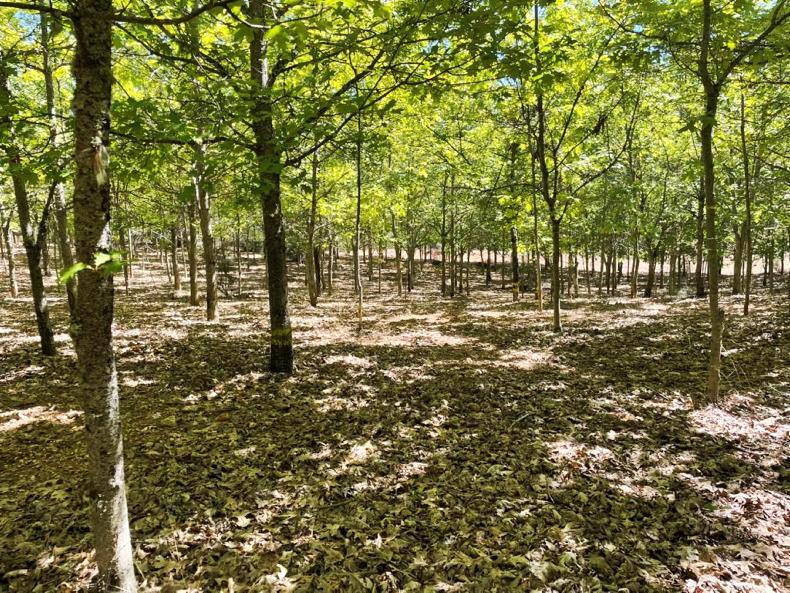
Red oak plantation planted 25 years ago in the Miranda Plateau, Portugal, after successive crops of wheat and barley failed. \ Donal Magner
They chose oak – but not the native species. Instead, they opted for red oak (Quercus rubra), a native of southeast Canada and northeastern US. Renowned for its vigour and autumn colour, it is an important tree for furniture making and flooring.

While sophisticated technology has been introduced in cooperage, traditional methods are still required by skilled coopers in the burning and toasting process as well as securing the casks. \ J.M. Gonçalves
The 500ha forest we visited in the Miranda Plateau is now 25 years old and involves approximately 40 farmers.
The transition from yearly agricultural production cycles to managing a crop that will need generations to mature has proved challenging. The forest should have been thinned five years ago, but co-ordinating all farmers to become fully involved is at last bearing fruit.
Now, farmers are ready to reduce the existing stocking of 600 trees/ha to 400/ha after first thinning. The management approach is a combination of traditional forestry and silvopasture.
The crop, which is growing well, carries a goat herd, which was part of traditional farming and shepherding in this area. Aside from producing cheese and meat, goats are efficient at keeping vegetation under control.
The farmers receive an annual premium of €200/ha to compensate for the loss of their agricultural income. The income seems low, but has to be taken in context of the cost of living in this part of rural Portugal, which is lower than in other areas.
The monthly minimum wage in Portugal is €760 compared with €1,910 in Ireland.
Cooperage tradition
Oak is also the main form of conservation in the nearby village of Palaçoulo, where the world-class cooperage J.M. Gonçalves is located. The area has a strong cooperage tradition going back centuries, while the Gonçalves family-owned company began cask-making in the early 20th century.
Unlike other countries – including Ireland – which lost their native oak, Portugal has preserved its cooperage heritage. The company imports oak staves; American white oak (Quercus alba) from northeast US, while pedunculate (Q robur) and sessile oak (Q petraea) are sourced in France.
They export the casks back to these countries, as well as other whiskey, cognac and wine-producing countries, where the Gonçalves slogan “do bosque à adega” – from the forest to the cellar – is a byword in international coopering.
Why is there no plan in place for
large-scale damage to Irish forests?
Most European countries are now planning for climate change-related disasters in land use, including forestry. Countries which experience massive windblow, disease and fire allow speedy removal of damaged trees.
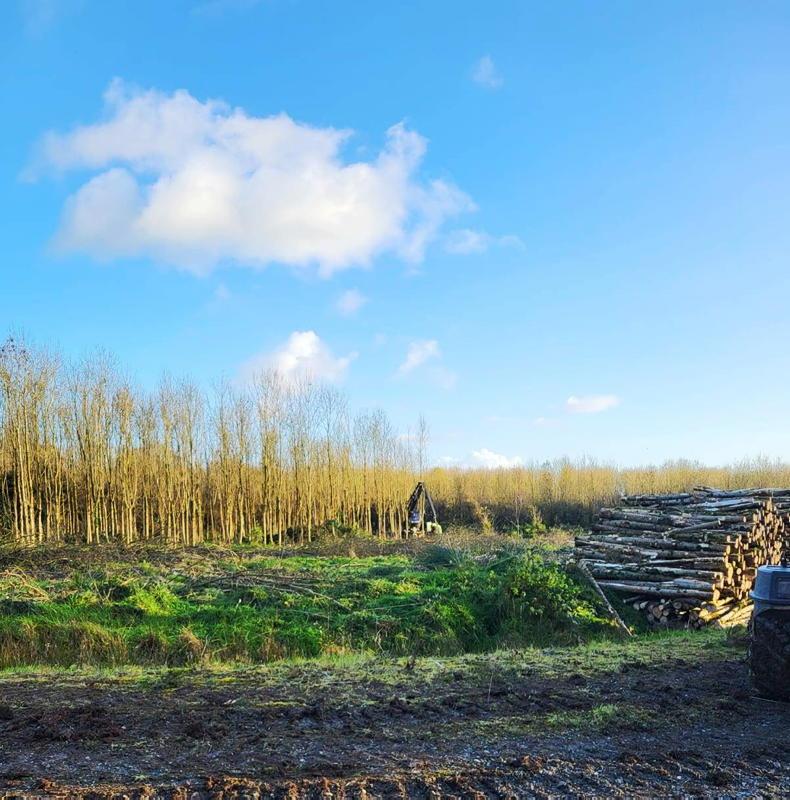
Ash clearance finally begins in Billy Lee’s plantation after application to fell was submitted in 2019. \ John Roche
When I visited Sweden in February 2005, a month after the disastrous storm Gudrun flattened 75m m3 of timber, harvesting was well underway. Within months, virtually all windblown trees were removed.
Why must Irish forest owners, with windblown or diseased trees, wait for months and even years before they receive felling licences to remove rotting timber?
Why, three-and-a-half years after applying for a felling licence on behalf of ash owner Billy Lee, can John Roche and his Arbor forestry team only now begin to remove the diseased trees?
Ireland has yet to put a contingency plan in place to urgently address large-scale damage to forests and woodlands, despite the threat of natural disasters and the potential introduction of bark beetle.
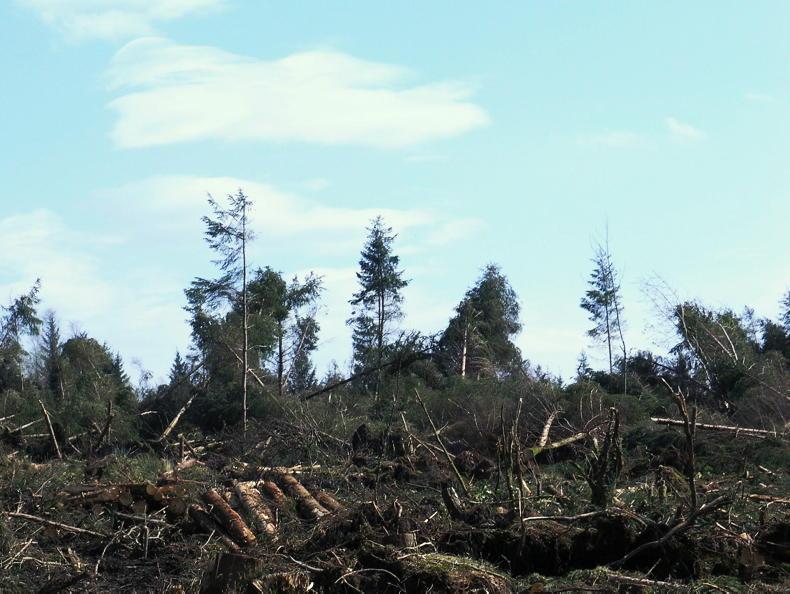
Windblown areas wait for up to a year and more for felling licence.
It is surely time a rapid response licensing system and State-private forestry insurance scheme were introduced to support forest owners who commit to a long-term land use such as forestry and its legal replanting obligation.
Apart from fires, which have devastated Portugal’s forests in recent years, a less obvious impact of global warming is negatively impacting on woodland structure, biodiversity and forest yield.
But the results of prolonged drought is evident when the country’s forests are explored and discussed with foresters and forest owners.
But it’s not just the forests that are suffering. Agriculture and horticulture are also being hit.
“Portugal is one of the countries most affected by climate change,” maintained Ursula von der Leyen at a European Council meeting in 2019, and it’s easy to see why the EU president made this statement.
During a recent visit to Portugal with the Society of Irish Foresters, I got a sense of Portugal’s battle against the relentless onset of global warming.
The Portuguese vary their approaches in adapting land use and forest conservation to climate change, depending on location and species. For example, in the State-owned Montesinho Natural Park, all pines, including the native maritime pine (Pinus pinaster), are being removed to favour indigenous broadleaves.
Clearfelling underway
When we visited the park, plans were in place to clearfell the diseased and fire-damaged pine forests, in collaboration with villagers who benefited from these once-lucrative forests.
Now, they are being clearfelled in a State-community partnership to make way for native broadleaves.
The income from the forest harvest is divided between the community (60%) and the State (40%). Each village decides democratically on the distribution of the revenue. This is then shared out to individual families.
Although some of the funding goes back into forest improvement, the responsibility for reforestation rests with the State – the owners of the land.
Nearby, an area which was transformed to a native oak woodland 30 years ago is being monitored for future management as part of an EU Life project, led by Marina Castro and administered by Bragança Polytechnic Institute in partnership with other stakeholders.
The two native oak species – holm (Quercus ilex) and Pyrenean (Q pyrenaica) – are being managed in collaboration with the villagers who, in this instance, own the land.
Here, local shepherds take an active interest in the conservation and management of the woodland, as it provides grazing for their native and endangered sheep breeds.
The Life project monitors all aspects of woodland to ensure it is more resilient against fire and disease. The project also explores how the forest could potentially provide an income through carbon credits.
Red oak replaces failed agriculture crops while traditional cooperage is alive and well in Portugal
Forestry and agriculture are both suffering in the face of heatwaves in Portugal, and nowhere is this more evident than in the Miranda Plateau.
Farmers in this area abandoned wheat and barley growing in the 1980s after years of crop failure due to drought. The challenge they faced was to examine alternative crops so that they could continue to work the land.
Their choices were limited, as annual precipitation is down to 600mm in the area, so any form of cereal production was impossible.
They explored forestry as a land-use option, explained Jorge Machado, administrator of the Forest Producers Association, which represents the farmers.
They looked to native pine and oak, but the best advice was that these species would probably fail in the area’s dry harsh conditions.

Red oak plantation planted 25 years ago in the Miranda Plateau, Portugal, after successive crops of wheat and barley failed. \ Donal Magner
They chose oak – but not the native species. Instead, they opted for red oak (Quercus rubra), a native of southeast Canada and northeastern US. Renowned for its vigour and autumn colour, it is an important tree for furniture making and flooring.

While sophisticated technology has been introduced in cooperage, traditional methods are still required by skilled coopers in the burning and toasting process as well as securing the casks. \ J.M. Gonçalves
The 500ha forest we visited in the Miranda Plateau is now 25 years old and involves approximately 40 farmers.
The transition from yearly agricultural production cycles to managing a crop that will need generations to mature has proved challenging. The forest should have been thinned five years ago, but co-ordinating all farmers to become fully involved is at last bearing fruit.
Now, farmers are ready to reduce the existing stocking of 600 trees/ha to 400/ha after first thinning. The management approach is a combination of traditional forestry and silvopasture.
The crop, which is growing well, carries a goat herd, which was part of traditional farming and shepherding in this area. Aside from producing cheese and meat, goats are efficient at keeping vegetation under control.
The farmers receive an annual premium of €200/ha to compensate for the loss of their agricultural income. The income seems low, but has to be taken in context of the cost of living in this part of rural Portugal, which is lower than in other areas.
The monthly minimum wage in Portugal is €760 compared with €1,910 in Ireland.
Cooperage tradition
Oak is also the main form of conservation in the nearby village of Palaçoulo, where the world-class cooperage J.M. Gonçalves is located. The area has a strong cooperage tradition going back centuries, while the Gonçalves family-owned company began cask-making in the early 20th century.
Unlike other countries – including Ireland – which lost their native oak, Portugal has preserved its cooperage heritage. The company imports oak staves; American white oak (Quercus alba) from northeast US, while pedunculate (Q robur) and sessile oak (Q petraea) are sourced in France.
They export the casks back to these countries, as well as other whiskey, cognac and wine-producing countries, where the Gonçalves slogan “do bosque à adega” – from the forest to the cellar – is a byword in international coopering.
Why is there no plan in place for
large-scale damage to Irish forests?
Most European countries are now planning for climate change-related disasters in land use, including forestry. Countries which experience massive windblow, disease and fire allow speedy removal of damaged trees.

Ash clearance finally begins in Billy Lee’s plantation after application to fell was submitted in 2019. \ John Roche
When I visited Sweden in February 2005, a month after the disastrous storm Gudrun flattened 75m m3 of timber, harvesting was well underway. Within months, virtually all windblown trees were removed.
Why must Irish forest owners, with windblown or diseased trees, wait for months and even years before they receive felling licences to remove rotting timber?
Why, three-and-a-half years after applying for a felling licence on behalf of ash owner Billy Lee, can John Roche and his Arbor forestry team only now begin to remove the diseased trees?
Ireland has yet to put a contingency plan in place to urgently address large-scale damage to forests and woodlands, despite the threat of natural disasters and the potential introduction of bark beetle.

Windblown areas wait for up to a year and more for felling licence.
It is surely time a rapid response licensing system and State-private forestry insurance scheme were introduced to support forest owners who commit to a long-term land use such as forestry and its legal replanting obligation.





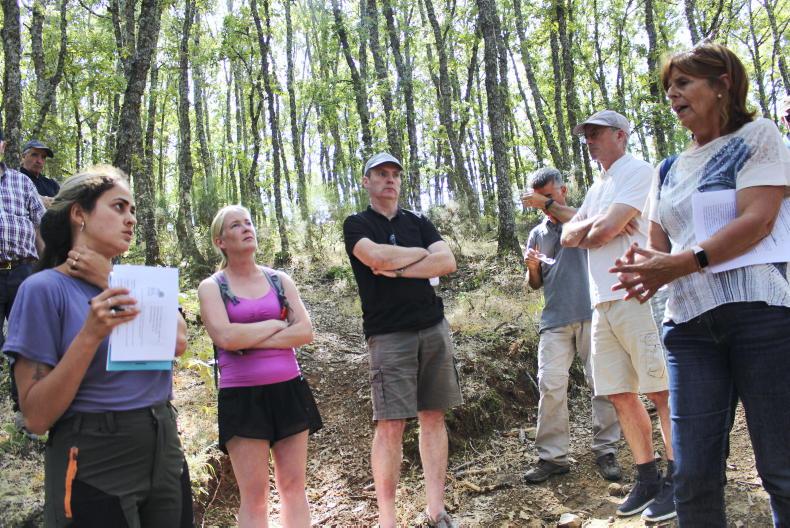




 This is a subscriber-only article
This is a subscriber-only article





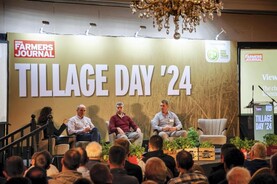




SHARING OPTIONS: